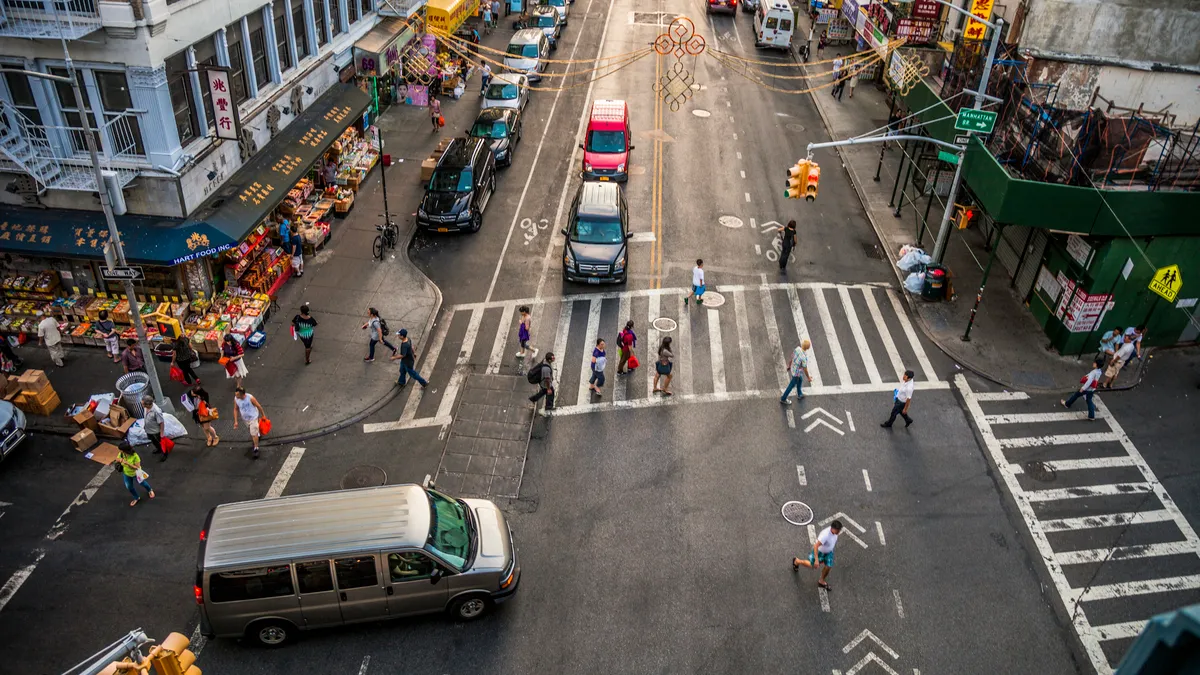Dive Brief:
- The solution to the problem of growing congestion in U.S. cities is transitioning existing parking structures and space into "staging areas" for supply chain and ride-share vehicles, according to a new report from PwC in partnership with the National Parking Association.
- The report suggests designating street and garage space for use by vehicles that need to come and go efficiently — or in the case of ride-share, a trip with no passenger or cargo waiting for a gig — could significantly cut down on road congestion and unnecessary emissions while reducing the $230-$300 billion cost of congestion in the U.S. every year, according to the report.
- "In this scenario, we're moving more traffic off the road so that the logistics and supply deliveries can continue to occur but they don’t have to worry about fines and penalties where they’re double parking and it gives them a different way of managing the range of real estate in very dense urban areas," Christine Banning, president of the National Parking Association told Supply Chain Dive.
Dive Insight:
The explosive growth in e-commerce has not decreased the use of private vehicles, according to PwC, and without changes to the way cities manage traffic, congestion is not likely to improve. An uptick in single-package deliveries, where one vehicle delivers only one package, failed first deliveries, and a return rate of roughly 30% for online orders, along with ride-sharing, have led to a situation where current strategies for congestion management are no longer sufficient.
Essentially PwC suggests designating parts of existing infrastructure, in the form of curbs, parking lots and garages, for ride-share drivers and the supply chain. Elements of this shift could include:
- Repurposing or repricing on-street parking.
- Reducing or eliminating parking minimums.
- Exploring new smart parking technologies.
- Reconsidering or repricing double parking fines.
- Leveraging parking as a “curb extension” or mobility hub.
Mobility hubs — defined as structures for both commuters and deliveries to stop or park and transfer to another, more efficient mode of transport — could include amenities like package lockers and dry cleaning along with multiple modes of alternative transport to get people and things to their final destinations, while keeping as many vehicles as possible off the streets.
"Being able to have short-term package drop-off zones in parking garages mean that FedEx, UPS and subcontractor shippers can all move in and out of the same structures at the same time, whereas today with loading and unloading zones often, once one vehicle is there, that block is tied up," said Banning, who added that several pilots testing the hub concept are currently in progress in the U.S.
Such a concept would require a behavioral change, as well as greater efficiency for both commuters and logistics providers. But the knock-on results for 3PLs could be fewer tickets, lower total parking violation fines and more precisely-timed delivery windows via the reduction of congestion and uncertainty that comes with parking in dense urban areas.
Regardless of whether cities move toward the "mobility hub" or curb management models, cities, service providers, ride-hailing companies and other stakeholders need to seek out solutions that benefit all parties, said Alan Lazowski, chairman of the National Parking Association.
"We're just starting to have conversations around how we can help make [3PL] flow easier and what role can we play as having first and last mile real estate," said Lazowski. "We have to all figure out how we make it easier and better for each other."













